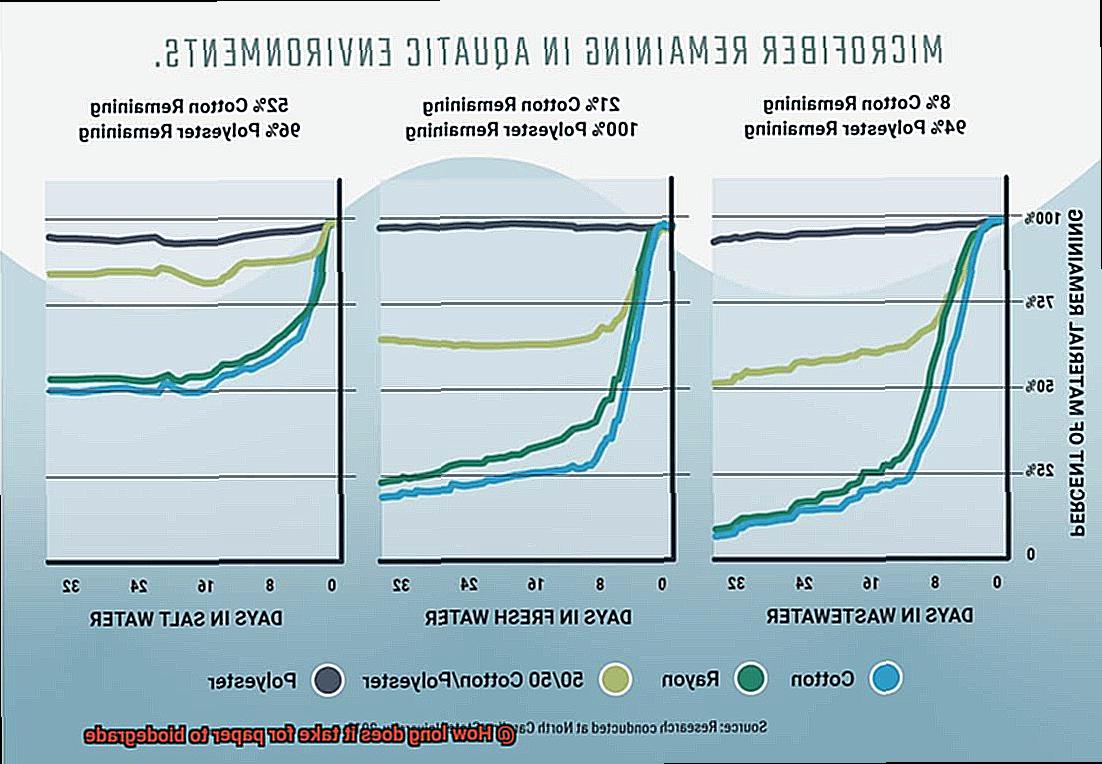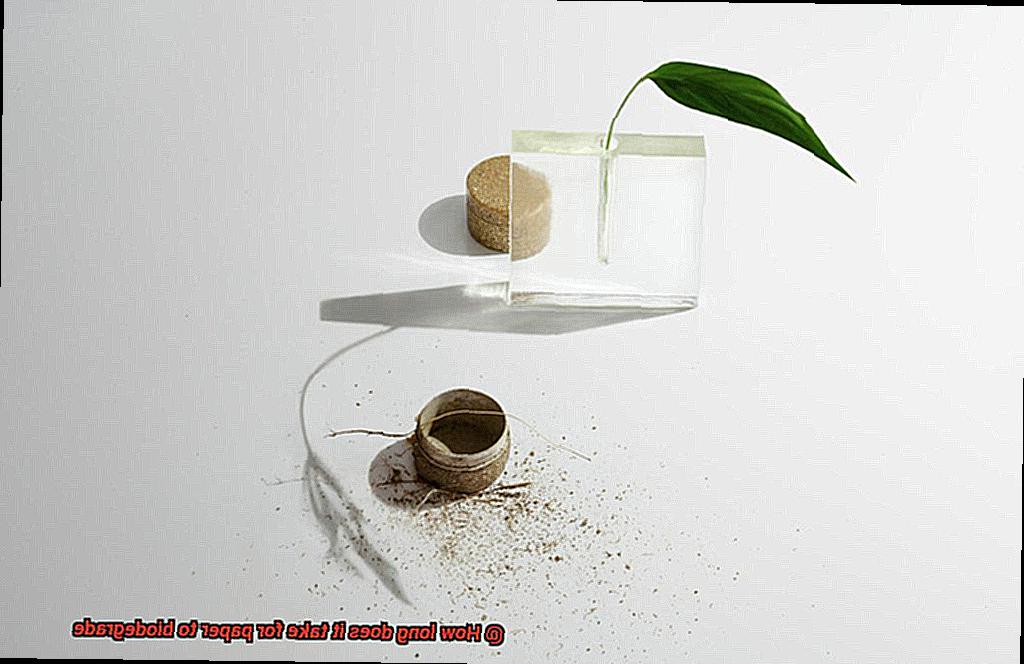Did you know that the average American consumes a whopping 700 pounds of paper every year? That’s equivalent to a staggering 187 billion pieces of paper used annually in the United States alone. But have you ever wondered what happens to all that paper once it’s no longer useful? How long does it take for it to biodegrade?
These are crucial questions to ponder, particularly as we become more aware of our impact on the environment. As a material, paper is biodegradable, which means it can be broken down naturally by bacteria and other microorganisms. However, the length of time it takes for paper to fully decompose depends on various factors such as how it’s treated and where it’s disposed of.
In this blog post, we’ll delve into the nitty-gritty details of paper biodegradation, including examining different types of paper and their decomposition duration. We’ll also analyze the environmental impact of paper production and suggest ways we can reduce our reliance on paper for a more sustainable future. So whether you’re an avid reader, a student or just someone who wants to lead an eco-friendly lifestyle, this post is perfect for you. Get ready to immerse yourself in learning everything about how long it takes for paper to biodegrade.
What is Biodegradable Paper?
Contents
Unlike conventional paper products that can be harmful to the environment, biodegradable paper is made from natural materials like bamboo, hemp, or sugarcane bagasse. These renewable resources can be sustainably harvested, which makes the production of biodegradable paper much less harmful to the planet.
Furthermore, biodegradable paper is produced using environmentally-friendly production methods that minimize the use of harmful chemicals and energy. This means that it is a much more eco-friendly option than traditional paper, which is often treated with chemicals that prevent it from breaking down easily.
One of the most significant benefits of biodegradable paper is its ability to break down quickly and efficiently in composting systems. When biodegradable paper is composted, it decomposes into its basic components, leaving no harmful residue behind. This makes it an ideal choice for businesses and individuals who are looking to reduce their environmental impact and promote sustainability.
Another important benefit of biodegradable paper is that it can be recycled. When paper products are recycled, they are broken down and reprocessed into new products rather than being sent to a landfill where they may take years to decompose. By choosing biodegradable paper products and properly disposing of them through recycling or composting, we can all do our part to minimize our impact on the environment.
It’s worth noting that uncoated biodegradable paper products can take anywhere from 2-6 weeks to biodegrade under ideal conditions. However, if the paper is exposed to moisture and sunlight, it may break down even more quickly. On the other hand, coated paper products such as glossy magazines or laminated documents can take much longer to decompose.

Factors Affecting the Degradation Rate of Paper
Type Of Paper
The first factor is the type of paper. Not all papers degrade at the same rate. Glossy and coated papers take longer to break down compared to uncoated papers. The reason for this is that coated papers contain chemicals that make them resistant to moisture and air, making them harder to break down. So, if you’re looking for a paper product that degrades quickly, opt for uncoated paper.
Environmental Conditions
Next up is environmental conditions. Temperature, humidity levels, and sunlight exposure can all impact how quickly paper degrades. Higher temperatures and humidity levels create ideal conditions for microorganisms like bacteria and fungi to thrive, breaking down paper into organic compounds more efficiently. When exposed to UV radiation from sunlight, some types of paper can also break down more quickly.
Microorganisms
Lastly, microorganisms play a significant role in the degradation process. Bacteria and fungi are responsible for breaking down paper into simpler organic compounds. They require access to oxygen, water, and nutrients to do their job effectively.
If these critical elements are lacking or if the environment is too hostile for them, then the degradation process will slow down significantly.
Understanding the factors that impact paper degradation is vital in promoting sustainable practices and reducing waste. By selecting the right type of paper, creating ideal environmental conditions, and supporting microorganism activity, we can develop more efficient waste management strategies that benefit our planet.
How Long Does Uncoated Paper Take to Biodegrade?
Uncoated paper is an eco-friendly option that is made from natural materials like wood pulp and contains no chemicals or polymers. While it is generally faster to biodegrade than coated paper, several factors can impact its rate of decomposition.
The most significant factor that affects how quickly uncoated paper biodegrades is the environment in which it is disposed of. If you dispose of uncoated paper in a composting environment, it will be exposed to moisture, oxygen, and microorganisms that break down its organic materials quickly. However, if you dispose of uncoated paper in a landfill, it may take much longer to biodegrade due to the lack of oxygen and moisture needed for decomposition.
The thickness and size of the uncoated paper can also impact its biodegradation rate. Smaller pieces of paper will generally break down faster than larger ones. Furthermore, thicker paper may take longer to break down due to its density.
Research conducted by the University of California found that plain white uncoated paper took about 2-5 months to decompose in a composting environment while it took up to 5 years to decompose in a landfill. This indicates that uncoated paper can take anywhere from weeks to months or even years to completely biodegrade, depending on the specific conditions it is exposed to.
How Long Does Coated Paper Take to Biodegrade?
Coated paper is a popular choice for printing applications, given its ability to enhance properties like water resistance, print quality, and gloss. But, have you ever wondered how long it takes for coated paper to break down? The answer is not so simple, as the time it takes for coated paper to decompose depends on various factors.
The coating material used is one of the most critical factors that determine how long coated paper takes to biodegrade. Plastic-coated paper, for instance, can take up to five years to fully decompose. This is because plastic takes much longer to break down compared to other coating materials.
Moreover, the way we dispose of coated paper also plays a vital role in its biodegradation process. Disposing of coated paper in landfills can take decades or even centuries since landfills lack air and moisture required for biodegradation. However, composting coated paper in controlled environments with proper temperature and moisture levels can break it down in just a few months.
To reduce the impact of coated paper on the environment, we should dispose of it properly and consider using eco-friendly alternatives like uncoated or eco-coated papers whenever possible. By doing so, we can reduce waste in landfills and promote more sustainable practices.
Recycling as an Alternative to Disposal
When it comes to paper waste, recycling is an excellent alternative to disposal. By converting used paper into new paper products, we reduce the need for virgin pulp, which minimizes the environmental impact of paper production. Plus, recycling keeps paper out of landfills where it can take up space and contribute to greenhouse gas emissions as it decomposes.
The amount of time it takes for paper to biodegrade varies depending on several factors, including the type of paper and its environment. Uncoated paper products like newspapers and office paper can biodegrade in about two to six weeks in a composting environment. However, coated papers like glossy magazines and brochures can take much longer to break down due to their chemical composition.
Aside from reducing the need for disposal, recycling paper also conserves natural resources. According to the Environmental Protection Agency (EPA), recycling one ton of paper saves approximately 17 trees, 7,000 gallons of water, 3 cubic yards of landfill space, and enough energy to power an average American home for six months. That’s impressive, right? Moreover, recycling paper reduces greenhouse gas emissions generated during production and transportation of virgin pulp.
bXfEG-CnQ8I” >
Conclusion
In conclusion, paper is an essential part of our daily lives, but it comes with a responsibility to care for the environment. As we consume 700 pounds of paper per year on average in America, it’s crucial to dispose of it properly and consider its biodegradability. While paper can be broken down by microorganisms naturally, several factors affect the rate of decomposition.
Uncoated paper decomposes much faster than coated papers like glossy magazines and brochures due to their chemical composition. Composting environments can take between two to six weeks for uncoated paper to biodegrade. However, coated papers may take significantly longer.
To reduce our environmental impact, eco-friendly alternatives like biodegradable or recycled paper products are worth considering. Biodegradable paper is made from natural materials and produced using environmentally-friendly methods that minimize the use of harmful chemicals and energy. Recycling paper conserves natural resources and reduces greenhouse gas emissions generated during production.
Understanding the factors that influence paper degradation is vital in promoting sustainable practices and reducing waste. By selecting the right type of paper, creating ideal environmental conditions, and supporting microorganism activity, we can develop more efficient waste management strategies that benefit our planet.





